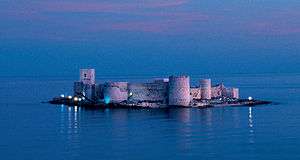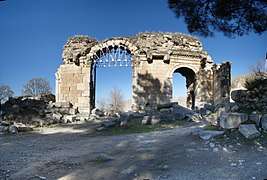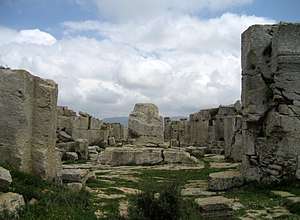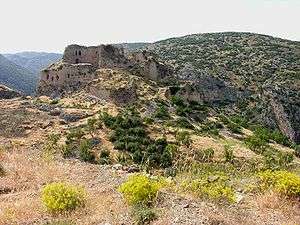Çukurova
Çukurova (Turkish pronunciation: [tʃuˈkuɾova]), alternatively known as Cilicia, is a geo-cultural region in south-central Turkey, covering the provinces of Mersin, Adana, Osmaniye and Hatay. With a population of almost 6 million, it is one of the largest population concentrations in Turkey.
Çukurova | |
|---|---|
Region | |
 Location of Çukurova within Turkey | |
| Coordinates: 36°52′N 35°29′E | |
| Country | |
| Largest city | Adana |
| Provinces | Mersin, Adana, Osmaniye, Hatay |
| Area | |
| • Total | 38,585.16 km2 (14,897.81 sq mi) |
| Population (2015)[1] | |
| • Total | 5,974,768 |
| • Density | 154.846/km2 (401.05/sq mi) |
| Time zone | UTC+2 (EET) |
| • Summer (DST) | UTC+3 (EEST) |
| Postal code prefixes | 33xxx, 01xxx, 80xxx, 31xxx |
| Area code(s) | 324, 322, 328, 326 |
Çukurova in Turkish means roughly "Low Plain", çukur for "hollow, depression", ova for "plains". The region starts from Anamur at the west, extending east along the Mediterranean Sea, stretching as far north as Tufanbeyli, wrapping around the Gulf of İskenderun, turning south at Erzin and finally terminating at Yayladağı on the border of Syria. The core area is Çukurova plain (formerly Cilicia Pedias), covering the area of Mersin on the west, Kozan on the north, Osmaniye on the east and the Mediterranean on the south. Adana-Mersin Metropolitan Area is the business and cultural center of Çukurova.
Most of the Çukurova region is a large stretch of flat, fertile land which is among the most agriculturally productive areas of the world. Throughout history, Çukurova was a gateway from Europe to the Middle East. It is the shortest access point to the Mediterranean from the northern Middle East and Central Asia. It is a transportation hub, with its two major seaports and oil terminal.
History
The region's recorded history dates back over 6,000 years. Armenian presence in Cilicia dates back to the first century BC, when under Tigranes the Great, the Kingdom of Armenia expanded and conquered a vast region in the Levant. In 83 BC, the Greek aristocracy of Seleucid Syria, weakened by a bloody civil war, offered their allegiance to the ambitious Armenian king.[2] During the Roman and early Byzantine Empires, the capital of Cilicia province was the important seaport of Tarsus, where Mark Antony met Cleopatra, and birthplace of Paul the Apostle and Theodore of Tarsus, among other important missionaries.
The region became an early battleground between Muslim and Christian forces, and was conquered in the 8th century and remained part of the Abbasid Caliphate until reconquered by Byzantine forces in 962. Shortly after, in 1080, Ruben founded the Armenian Kingdom of Cilicia.

When Seljuq Turks captured the region in the 12th century, many Turkmens, including Oğuz clans of Yureğir, Afshar and Chepni settled in the region's northern parts under the direction of Ramadanids. Those who preserved the nomadic lifestyle were named Yörüks. As of the 18th century, the Ottoman Empire pursued a policy aimed at settling these populations in permanent settlements; the process was more or less complete in the 19th century, although it involved many difficulties and much tension.
Between the 1832 Convention of Kütahya leaving the territorial gains acquired by Ibrahim Pasha of Egypt to his administration till the 1841 London Conference convened to settle the question, Çukurova remained under the rule of the Khedive of Egypt. Although the period of Egyptian rule, motivated by Egypt's perennial need, timber for the navy, was relatively short, it left important marks in such areas as the introduction of industrial-scale cotton production and new arrivals into the population tissue of the region. Cottonpickers of Çukurova still start their workday with prayers for the memory of İbrahim Pasha, and the locally influent Menemencioğlu family, with notable descendants till our day, including Turkey's foreign minister during the Second World War, Numan Menemencioğlu, rose to notability by acting as middlemen for the Pasha. Among other families still prominent today and that had risen with the cotton boom, Kozanoğlu, Güveloğlu, Kerimoğlu, Karsantıoğlu, Küçükalioğlu families can be cited.
In 1869, the Vilayet of Adana (Adana Province) was incorporated after splitting up Aleppo Province.[3] The borders of the Vilayet of Adana are similar to today's Çukurova region.
The development of Mersin as a major port also began during this period. As a result, the cities of the region became prominent centers of trade, farming and industry. Today, Adana is the 5th largest city of Turkey, and a vital center of many agricultural products such as cotton.
Geography
Historically, the region was known as Kizuwatna by the Hittites and it was divided into two parts, Uru Adaniya (flat Cilicia) and western Cilicia (Tarza), which was also known as the mountainous Cilicia. The gates which allow passage from Çukurova into the Central Anatolian Plateau through the Taurus Mountains, the Cilician Gates of antiquity, is called Gülek Pass today. Belen Pass which connects the region to the southeast (to the modern district of Dörtyol in Hatay Province) and Sertavul Pass constitute other important points of passage. The region is included in the Mediterranean region of Turkey, and it borders Central Anatolia (historical Cappadocia) to the north, and Southeastern Anatolia to the east.
Natural resources
Agriculture
The Çukurova plain has some of the most fertile soil in the world in which 3 harvests can be taken each year. The region has the second richest flora in the world and it is the producer of all agricultural products of Turkey except hazelnut and tobacco. Çukurova leads Turkey in soy, peanuts and corn harvest and is a major producer of fruits and vegetables. Half of Turkey's citrus export is from Çukurova. Anamur is the only sub-tropical area of Turkey where bananas, mango, kiwi and other sub-tropical produce can be harvested.
Çukurova is the second largest honey producer in Turkey after the Muğla–Aydın region.[4] Samandağ, Yumurtalık, Karataş and Bozyazı are some of the towns in the region where fishing is the major source of income. Gray mullet, red mullet, sea bass, lagos, calamari and gilt-head bream are some of the most popular fish in the region. There are aquaculture farms in Akyatan, Akyağan, Yumurtalık lakes and at Seyhan Reservoir. While not as common as other forms of agriculture, dairy and livestock are also produced throughout the region.
Mining
- Zinc and lead: Kozan-Horzum seam is the major source.
- Chrome is found around Aladağlar.
- Baryte resources are around Mersin and Adana.
- Iron is found around Feke and Saimbeyli.
- Asbestos mines are mostly in Hatay Province.
- Limestone reserves are very rich in Çukurova. The region is home to four lime manufacturing plants.
- Pumice resources are the richest in Turkey. 14% of country's reserves are in Çukurova.
Lying at a crossroads of three major religions, namely Judaism, Christianity and Islam, the region is home to numerous landmarks that are important for people of faith. Tarsus is the birthplace of St. Paul, who returned to the city after his conversion. The city was a stronghold of Christians after his death. Ashab-ı Kehf cavern, one of the locations claimed to be the resting place of the legendary Seven Sleepers, holy to Christians and Muslims, is located north of Tarsus. Antakya is another destination for the spiritual world, where the followers of Jesus Christ were first called Christians. It is the home of Saint Peter, one of the 12 saints of Jesus.[5]
The region is a popular destination for thermal springs. Hamamat Thermal Spring, located on midway from Kırıkhan to Reyhanlı, has a very high sulphur ratio, making it the second in the world after a thermal spring in India.[6] It is the largest spa in the region and attracts many Syrians due to proximity. Haruniye Thermal Spring is located on the banks of the Ceyhan River near Düziçi town and has a serene environment. Thermal springs are a hot spot for people with rheumatism.[7] Kurttepe, Alihocalı and Ilıca mineral springs, all located in Adana Province, are popular for toxic cleansing. Ottoman Palace Thermal Resort & Spa in Antakya is one of Turkey's top resorts for revitalization.
Places of interest
Ancient sites

Kizkalesi (Maiden Castle), a fort on a small island across Kızkalesi township, was built during the early 12th century by Armenian kings of the Rubeniyan dynasty, to defend the city of Korykos (today Kızkalesi).
Heaven & Hell, situated on a large hill north of Narlıkuyu, consists of the grabens result from assoil of furrings for thousands of years. Natural phenomena of the grabens is named 'Hell & Heaven' because of the exotic effects on people. From an ancient path, 260 meter long mythological giant Typhon's cave can be accessible.[8]
The ancient Roman town of Soloi-Pompeiopolis, near the city of Mersin.
Yılanlı Kale (Castle of Serpents), an 11th-century crusader castle built on a historical road connecting Taurus mountains to the city of Antakya. Castle has 8 round towers, and there ıs a military guardhouse and a church in the castle. Castle is located 5 km. west of Ceyhan.[9]
Anazarbus Castle was built in the 3rd century and served as the center of the ancient metropolis of Anavarza. The city was built on a hill and had a strategic importance, controlling the Çukurova plain. Main castle and the city walls are remains of the city. City wall is 1500m. long and 8-10m. high and there are 4 entrances to the city. Castle is located 80 km. northeast of Adana.
Şar (Comona), ancient city located in northernmost Çukurova, some 200 km. north of Adana, near Tufanbeyli. It is a historical center of Hittites. Remaining structures today are, the amphitheatre built during Roman period, ruins of a church from Byzantine and rock works from Hittites.[10]
Church of St. Peter in Antakya, was converted into a church while it was a cave on the slopes of Habibi Neccar mountain. The church is known as first Christians' traditional meeting place. The church was declared as "Place of Pilgrimage" for Christians by Pope IV Paul in 1963, and since then special ceremony is held on 29 June of each year.
St. Simeon Monastery, a 6th-century giant structure built on a desolate hill 18 km south of Antakya. The most striking features of this monastery are cisterns, storage compartment and the walls. It is believed that St. Simeon lived here for 45 years on a 20-meter stone column.
Parks and conservation areas
Akyatan Lagoon is a large wildlife refuge which acts as a stopover for migratory birds voyaging from Africa to Europe. The wildlife refuge has a 14,700-hectare (36,000-acre) area made up of forests, lagoon, marsh, sandy and reedy lands. Akyatan lake is a natural wonder with endemic plants and endangered bird species living in it together with other species of plants and animals. 250 species of birds are observed during a study in 1990. The conservation area is located 30 km south of Adana, near Tuzla.[11]
Yumurtalık Nature Reserve covers an area of 16,430 hectares within the Seyhan-Ceyhan delta, with its lakes, lagoons and wide collection of plant and animal species. The area is an important location for many species of migrating birds, the number gets higher during the winters when the lakes become a shelter when other lakes further north freeze.[12]
Aladağlar National Park, located north of Adana, is a huge park of around 55,000 hectares, the summit of Demirkazik at 3756 m is the highest point in the middle Taurus mountain range. There is a huge range of flora and fauna, and visitors may fish in the streams full of trout. Wildlife includes wild goats, bears, lynx and sable. The most common species of plant life is black pine and cluster pine trees, with some cedar dotted between, and fir trees in the northern areas with higher humidity. The Alpine region, from the upper borders of the forest, has pastures with rocky areas and little variety of plant life because of the high altitude and slope.[13]
Karatepe-Aslantaş National Park located on the west bank of Ceyhan River in Osmaniye Province. The park include the Karatepe Hittite fortress and an open-air museum.
Tekköz-Kengerlidüz Nature Reserve, located 30 km north of Dörtyol, is known for having an ecosystem different from the Mediterranean. The main species of trees around Kengerliduz are beech, oak and fir, and around Tekkoz are hornbeam, ash, beach, black pine and silver birch. The main animal species in the area are wild goat, roe deer, bear, hyena, wild cat, wagtail, wolf, jackal and fox.[14]
Habibi Neccar Dağı Nature Reserve is famous for its cultural as well as natural value, especially for St Pierre Church, which was carved into the rocks. The Charon monument, 200 m north of the church, is huge sculpture of Haron, known as Boatman of Hell in mythology, carved into the rocks. The main species of tree are cluster pine, oaks and sandalwood. The mountain is also home to foxes, rabbits, partridges and stock doves. Nature reserve is 10 km east of Antakya and can be accessible by public transport.[15]
Çukurova in popular culture
Culturally, the life and the hardships faced by the ordinary people of Çukurova was brought to the screen by many Turkish film directors including Yılmaz Güney, especially in his 1970 masterpiece Umut (The hope). It is impossible to make a reference to Çukurova without mentioning the internationally acclaimed author who gave the region legendary dimensions, Yaşar Kemal.
Image gallery
 Zeus Temple-Silifke
Zeus Temple-Silifke Kanlıdivane
Kanlıdivane Soloi-Pompeiopolis
Soloi-Pompeiopolis South gate of Anazarbus Castle
South gate of Anazarbus Castle- West gate Anazarbus Castle
 Castabala Amphitheater-Osmaniye
Castabala Amphitheater-Osmaniye Monastery of St Simeon-Hatay
Monastery of St Simeon-Hatay Baghras in Hatay
Baghras in Hatay
References
- "Archived copy". Archived from the original on 2016-02-04. Retrieved 2016-10-14.CS1 maint: archived copy as title (link)
- Hye Etch. "King Tigran II – The Great". Archived from the original on 21 February 2007. Retrieved 2007-01-17.
- Tahir Sezen "Osmanlı yer adları" sf. 6, T.C. Başbakanlık Devlet Arşivleri Genel Müdürlüğü (2006).
- "Türkiye'de Arıcılık". Assale. Retrieved June 1, 2009.
- "Hatay". Ministry of Culture and Tourism. Retrieved 2020-02-21.
- "Hatay Hamamat Kaplıcası (Turkish)". Kaplıca ve Termal Turizm. Retrieved 2020-02-21.
- "Haruniye Kaplıcaları (Turkish)". Kaplıca ve Termal Turizm. Retrieved 2020-02-21.
- "Heaven & Hell". ÇUKTOB. Retrieved 2020-02-21.
- "Yılanlı Kale". ÇUKTOB. Retrieved 2020-02-21.
- "Adana Governship (Turkish)".
- "Akyatan Bird Sanctuary". Çukurova Touristic Hoteliers Association. Retrieved 2020-02-21.
- "Yumurtalık Nature Reserve". Ministry of Culture and Tourism. Retrieved 2020-02-21.
- "Aladağlar National Park". Ministry of Culture and Tourism. Retrieved 2020-02-21.
- "Tekkoz-Kengerlidüz Nature Reserve". Ministry of Culture and Tourism. Retrieved 2020-02-21.
- "Habibi Neccar Dagi Nature Reserve". Ministry of Culture and Tourism. Retrieved 2020-02-21.